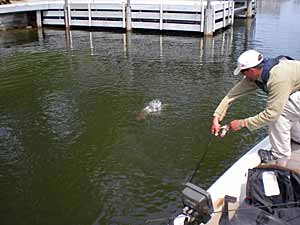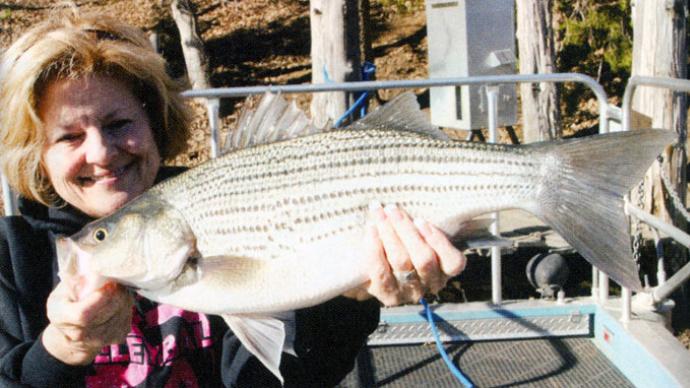
When I was fishing tournaments, I spent little time searching for those “other bass” species – like white bass, stripers, and hybrids. But now that I’m hosting a TV show and fishing more for fun, I don’t overlook those opportunities. When they’re active, there’s not a fish that’s more exciting to catch than these “other bass.”
The reasons are simple. They’re powerful and determined, and in the case of hybrids and stripers, they grow enormous. The white bass may not be as big, but pound for pound, it’s as challenging at the end of a line as any fish you’ll hook.
The white bass is built like a crappie, yet it has the strength and determination of a smallmouth. It feeds aggressively, roams in schools, and will take the rod from your hand if you’re not paying attention.
Stripers are more finicky, but when they’re found feeding on the surface, it can be the experience of a lifetime. They grow huge – 40-pounders can be caught! The hybrid striper, on the other hand, is a cross between the white and striper, producing a more aggressive fish that grows larger than a white bass but smaller than a striper. White bass reproduce naturally in most waters, while stripers and hybrids are reared in hatcheries.
My first hybrid encounter was several years ago while preparing for a tournament on Lake Seminole. I drove upstream near the Columbia Dam, where a nuclear plant discharges water into a canal. I expected to find largemouth, but instead, the hybrids were feeding wildly. Incidentally, I missed four hours of tournament practice because I had so much fun catching 8- to 10-pound fish on a Mann’s Sting Ray Grub and 8-pound test line.
Here’s a closer look at how and when to catch each species:
White Bass
White bass can be found in most reservoirs throughout the fishing season and rivers during early spring. Afterward, they migrate into the lake and hold near points and ledges next to deep water. They seem to school and feed best in the mornings and evenings, primarily through June and July. Good fishing continues into September, and October can be phenomenal.
During summer months, large schools of whites often are seen firing on shad. This ferocious surface activity can last several minutes, and if you’re there, you’ll catch them cast after cast without moving the boat.
Unlike stripers and hybrids that move often, white bass will hold in one area. When they’re surface feeding, you can catch them on almost anything – a shad – or minnow-imitating crankbait is a top choice. When the feeding frenzy stops, however, I like the Little George or Sting Ray Grub. The Little George has a fast-sinking metallic body with a tail spinner that can be jigged or ripped off the bottom. With frequent white-bass activity on a lake, I keep one tied and ready for action at all times.
Stripers
More anglers are giving up largemouth bass fishing to pursue stripers. I’d never do that, but I do enjoy pursuing stripers during the winter months. When water temperatures fall to the 40s and largemouth are challenging to catch, striper fishing can be excellent.
They’re most active from December through February on Lake Norman near my North Carolina home. One trick for locating them is to watch seagulls. When stripers are schooling and feeding on shad, gulls hover overhead, preparing to take their share of forage fish. I’ll cast a bucktail jig or spoon in the middle of the swirling birds and let the lure fall into the school. Having determined the depth at which fish are holding, I’ll key on that level the rest of the day.
During spring, there’s a natural migration of stripers to the river for spawning. It usually occurs when the water temperature reaches mid-50s.
From spring through early summer, stripers will take most bass lures that imitate minnows, but the bucktail jig or a large crankbait is hard to beat.
Hybrids
Hybrids have seasonal habits similar to stripers, except spring activity may be more productive than winter. They, too, will run up river arms and congregate near dams and other fast-water areas.
During spring, summer, and fall, they school near the surface and feed more actively than stripers, much like white bass. My favorite month to fish hybrids is September when they start running shad near the surface; this activity can stay hot through the fall.
Hybrids will hit a variety of lures, from small jigs to lipless crankbaits. Once fish are located, several can be caught in short order.
When fishing for any of these bass species, have a pair of binoculars handy to scan the surface for pockets of feeding activity. Keep binoculars nearby when fishing for largemouth, too. When black-bass action slows, look around the lake for whites, stripers, or hybrids ripping the surface. It can turn an average day of bass fishing into one of the most exciting trips of the year.
You can find more articles, quick tips, and more at HankParker.com.




